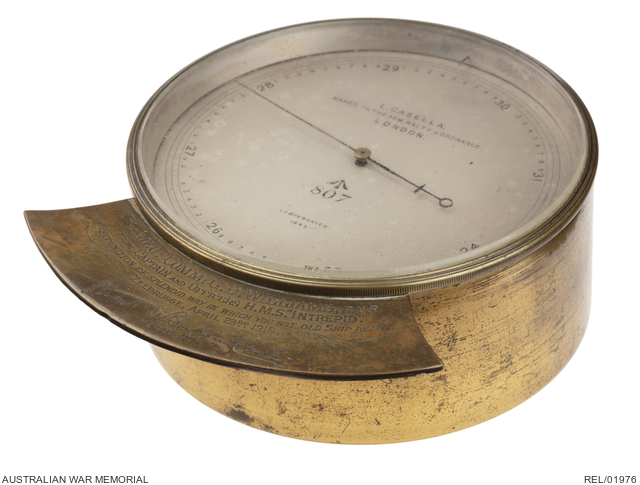| Place | Europe: Belgium, Zeebrugge |
|---|---|
| Accession Number | REL/01976 |
| Collection type | Heraldry |
| Object type | Heraldry |
| Physical description | Brass, Glass, Steel |
| Maker |
Casella, L |
| Place made | United Kingdom: England, Greater London, London |
| Date made | 1843 |
| Conflict |
First World War, 1914-1918 |
| Source credit to | This item has been digitised with funding provided by Commonwealth Government. |
Barometer : HMS Intrepid













Maritime barometer with engine-divided dial calibrated in inches of mercury with a range from 24 31, having stations at inches and 10th, divided to 1/50ths. The silvered face is marked ‘L.Casella. Maker to the Admiralty & Ordnance / London’. Below the fine blued steel pointer the barometer is marked ‘807 [Broad arrow mark] / Compensated 1843’. The barometer has a bevelled glass face, and a suspension ring at the top.
Diameter is 118mm and a depth of 50mm. Below the face is a curved metal collar with engraved text ‘TO LIEUT COMM:G.D.WILLIAMS, R.N.R, Captain and Officers H.M.S “Intrepid” / in recognition of splendid way in which you got old ship ready. ZEEBRUGGE APRIL 23rd 1918 [signed] Stuart S. Bonham-Carter LIEUT. R.N'
HMS Intrepid was an Apollo-class ship of the Royal Navy built on the River Clyde and launched in 1891. As she became obsolete as a cruiser she was converted into a minelayer. At the outbreak oif the First World War ‘Intrepid’ was based at Dover undertaking minelaying duties. In 1917 she became a depot ship as part of the British North Russia Squadron based at Murmansk.
The Zeebrugge raid to which the inscription refers was an attempt by the (British) Royal Navy to block the Belgian port of Bruges-Zeebrugge. Vice Admiral Sir Stuart Bonham-Carter (1889-1972) commanded the block ship HMS Intrepid at the Zeebrugge Raid in 1918.
The port was used by the Imperial German Navy as a base for U-boats, and presented a considerable threat to Allied control of the English Channel. As sinkings by U-boats increased, finding a way to close the ports became urgent.
A daring raid was planned, involving a flotilla of 76 ships carrying 1700 men. The plan also involved three obsolete ships, HMS Iphigenia, HMS Thetis and HMS Intrepid to be used as blockships. HMS Iphigenia and HMS Intrepid were filled with cement and scuttled in the narrowest part of the Bruges Canal. HMS Thetis did not reach the canal entrance but grounded on a sandbank and sank. A landing force to take over the breakwater that protected the harbour and on which the Germans had mounted numerous artillery pieces and machine guns was also planned. [Among the hundreds of RN and Royal Marine personnel involved in this action were a small group of Royal Australian Navy volunteers.] Formed into 200 man 'storming parties' and given instruction in trench warfare, assault tactics, bomb throwing, bayonet drill, and the use of mortars and Lewis machine guns, the idea was to inflict maximum damage on the port. The raid at Zeebrugge proved only a partial success. Over 200 British sailors were killed. The Germans lost 24 men. The blockships were sunk in the wrong place and the Germans, by removing two piers and dredging a channel, were able to open the canal to submarines after only a few days. ‘Intrepid’ was subsequently broken up when the canal was cleared.